Exploring the Role of Material Science in Advancing Quantum Machine Learning: A Scientometric Study
Abstract
1. Introduction
1.1. Objectives
1.2. Motivation and Contributions
- This study systematically examines the contributions of MatSci in the advancement of QML, a pivotal area in quantum computing. Additionally, it provides a comprehensive exploration of machine learning from a classical to quantum perspective, ensuring the article’s relevance and accessibility to a broad audience.
- By thoroughly analyzing the publication trends, this study recognizes the leading nations’ contributions to QML development through advancements in MatSci. Moreover, it shows the most impactful research papers through the citation analysis and provides critical insights into the state of the field.
- The collaborative network provides a detailed view of how nations are collaborating on QML research. This analysis uncovers the global research ecosystem and the interconnected efforts in this evolving domain.
- Through overlay network analysis and keyword co-occurrence, the study highlights the cutting-edge research areas and the latest technological trends in QML.
2. Literature Survey
3. Preliminaries
3.1. Machine Learning and Its Brief History
3.2. QML and Its Evolution
3.3. Material Science’s Contributions to Quantum Machine Learning
- Superconducting Qubits
- Superconducting materials like niobium (Nb) and aluminum (Al) exhibit zero electrical resistance at cryogenic temperatures, allowing for efficient quantum state preservation.
- These materials facilitate the creation of high-quality Josephson junctions (J.J.’s), which are critical for stabilizing quantum superposition and entanglement, and they also provide key benefits such as:
- (a)
- Minimal energy dissipation, reducing quantum errors.
- (b)
- Enhanced qubit performance, leading to improved computational efficiency.
- (c)
- Increased coherence time, enabling longer and more stable quantum computations.
- Topological Qubits
- Topological insulators and superconductors contribute to the development of topological qubits, which are highly resistant to errors.
- Quantum information in topological qubits is stored in a non-local state, meaning it is distributed across multiple locations.
- This property makes them highly resistant to local noise and decoherence, leading to improved fault tolerance.
- Two-dimensional Materials for Quantum Hardware
- Graphene and other 2D materials improve qubit connectivity and quantum gate operations by enabling better electron mobility and minimizing decoherence.
- These materials assist in creating low-loss transmission lines, enhancing quantum circuit performance.
- Quantum Memory and Storage
- Rare-earth-doped crystals serve as excellent quantum memory materials, improving quantum state storage and retrieval efficiency.
- These materials help in maintaining quantum coherence for longer periods, supporting error correction in QML algorithms.
- Quantum Sensors for QML Applications
- Advanced materials used in superconducting quantum circuits significantly improve QML applications by enabling higher precision, faster data acquisition, and enhanced sensitivity.
- These circuits enhance large-scale optimization in QML by boosting computational speed and reducing errors in learning algorithms.
3.4. Material Science Has Advanced Quantum Machine Learning
- Superconducting Materials for Faster Quantum Computing: Google’s Sycamore quantum processor uses superconducting qubits (made from niobium and aluminum) to achieve ‘quantum supremacy’, solving a complex problem faster than the best classical supercomputers. These superconducting circuits enable high-speed computations for QML models in fields like drug discovery, optimization, and cryptography.
- Topological Materials for Error-Resistant Quantum Systems: By cutting down on errors, topological materials make machine learning models much more dependable. This increased reliability makes Quantum Machine Learning more feasible for everyday tasks, like predicting financial risks and optimizing logistics with AI.
- Quantum Sensors in Biomedicine: Diamonds with nitrogen-vacancy (NV) centers are being used to create highly sensitive quantum sensors that can map brain activity down to the cellular level. These sensors capture incredibly precise biological data, which are then used in Quantum Machine Learning (QML) algorithms to help with early disease detection, drug discovery, and personalized treatments. This could lead to faster diagnoses, more effective medications, and tailored healthcare solutions for individuals.
- Cryogenic Materials: NASA and Google rely on liquid-helium-based cryogenic systems to keep quantum computers stable, allowing them to run complex simulations. This technology helps improve aerospace engineering designs and optimize satellite trajectories, making space missions more precise and efficient.
4. Research Methodology
5. Database Selection and Data Search
6. Selection of Visualization Tools
6.1. Selection of Keywords and Data Processing
- Defining the Research Scope:
- We identified key concepts at the intersection of QML and MatSci based on a preliminary literature review and expert consultations.
- The primary search terms included ‘Quantum Machine Learning’, ‘Materials for Quantum Computing’, ‘Quantum Materials’, ‘Quantum Computing in Material Science’, and their variations.
- Database Selection and Query Formulation:
- We sourced bibliographic data from the Web of Science (WoS) and Scopus, as these databases provide comprehensive and structured metadata on scientific publications.
- Boolean operators and wildcard searches were employed to refine results, ensuring the inclusion of relevant studies while minimizing noise.
- Data Collection and Cleaning:
- Retrieved data were exported in RIS, CSV, and BibTeX formats for compatibility with VOSviewer.
- Duplicate records were removed, and irrelevant entries were manually filtered based on title, abstract, and keyword relevance.
6.2. Co-Authorship Analysis and Network Construction
- Setting the Author Threshold:
- A total of 8299 authors contributed to the field, but to ensure meaningful visualization, only 57 authors meeting a predefined threshold (a minimum of five publications) were included in the network.
- The Total Link Strength (TLS) metric was used to quantify the strength of collaborations, representing the frequency and intensity of co-authorship connections.
- Network Visualization Using VOSviewer:
- VOSviewer was employed to generate a co-authorship network map, where nodes represent individual researchers, and edges denote collaborative links.
- The size of the nodes reflects the number of publications by each author, while the thickness of the edges represents the strength of co-authorship ties.
- Clustering algorithms within VOSviewer were used to detect research communities, identifying dominant collaboration groups.
6.3. Justification for Using VOSviewer
7. Analysis and Results
7.1. Publication and Citation Analysis
7.2. Global Distribution of Publications
7.3. Collaboration Analysis of Nations
- Clusters and Colors: Countries with the same color form a distinct research cluster, highlighting regional and strategic collaborations.
- Node Representation: The diameter of each node and its font size correspond to the significance of a country’s involvement in research collaborations.
- Connection Strength: The thickness of the connecting lines and the proximity of the nodes reflect the intensity of research collaboration between countries.
7.4. Most Significant Documents
7.5. Co-Authorship Analysis of Authors
7.6. Keyword Analysis
7.6.1. Cluster 1
7.6.2. Cluster 2
7.6.3. Cluster 3
7.6.4. Cluster 4
8. Conclusions
Funding
Conflicts of Interest
References
- Nielsen, M.A.; Chuang, I.L. Quantum Computation and Quantum Information; Cambridge University Press: Cambridge, UK, 2010. [Google Scholar]
- Chen, L.; Li, T.; Chen, Y.; Chen, X.; Wozniak, M.; Xiong, N.; Liang, W. Design and analysis of Quantum Machine Learning: A survey. Connect. Sci. 2024, 36, 2312121. [Google Scholar] [CrossRef]
- Vedral, V.; Plenio, M.B. Basics of quantum computation. Prog. Quantum Electron. 1998, 22, 1–39. [Google Scholar] [CrossRef]
- Berman, G.P. Introduction to Quantum Computers; World Scientific: Singapore, 1998. [Google Scholar]
- Crooks, G.E. Gates, States, and Circuits; Berkeley Institute for Theoretical Sciences (BITS): Berkeley, CA, USA, 2020. [Google Scholar]
- Senokosov, A.; Sedykh, A.; Sagingalieva, A.; Kyriacou, B.; Melnikov, A. Quantum Machine Learning for image classification. Mach. Learn. Sci. Technol. 2024, 5, 015040. [Google Scholar] [CrossRef]
- De Leon, N.P.; Itoh, K.M.; Kim, D.; Mehta, K.K.; Northup, T.E.; Paik, H.; Palmer, B.; Samarth, N.; Sangtawesin, S.; Steuerman, D.W. Materials challenges and opportunities for quantum computing hardware. Science 2021, 372, eabb2823. [Google Scholar] [CrossRef]
- Wang, P.; Luan, C.Y.; Qiao, M.; Um, M.; Zhang, J.; Wang, Y.; Yuan, X.; Gu, M.; Zhang, J.; Kim, K. Single ion qubit with estimated coherence time exceeding one hour. Nat. Commun. 2021, 12, 233. [Google Scholar] [CrossRef]
- Murray, C.E. Material matters in superconducting qubits. Mater. Sci. Eng. R Rep. 2021, 146, 100646. [Google Scholar] [CrossRef]
- Mercer, W.J.; Pashkin, Y.A. Superconductivity: The path of least resistance to the future. Contemp. Phys. 2023, 64, 19–46. [Google Scholar] [CrossRef]
- Citro, R.; Guarcello, C.; Pagano, S. Josephson junctions, superconducting circuits, and qubit for quantum technologies. In New Trends and Platforms for Quantum Technologies; Springer: Cham, Switzerland, 2024; pp. 1–59. [Google Scholar]
- Krasnok, A.; Dhakal, P.; Fedorov, A.; Frigola, P.; Kelly, M.; Kutsaev, S. Superconducting microwave cavities and qubits for quantum information systems. Appl. Phys. Rev. 2024, 11, 011302. [Google Scholar] [CrossRef]
- Kockum, A.F.; Nori, F. Quantum bits with Josephson junctions. In Fundamentals and Frontiers of the Josephson Effect; Springer: Cham, Switzerland, 2019; pp. 703–741. [Google Scholar]
- Lewis, B.R.; Templeton, G.F.; Luo, X. A scientometric investigation into the validity of IS journal quality measures. J. Assoc. Inf. Syst. 2007, 8, 35. [Google Scholar] [CrossRef]
- Serenko, A.; Bontis, N. Meta-review of knowledge management and intellectual capital literature: Citation impact and research productivity rankings. Knowl. Process. Manag. 2004, 11, 185–198. [Google Scholar] [CrossRef]
- Leydesdorff, L. Mapping interdisciplinarity at the interfaces between the Science Citation Index and the Social Science Citation Index. Scientometrics 2007, 71, 391–405. [Google Scholar] [CrossRef]
- Savov, P.; Jatowt, A.; Nielek, R. Identifying breakthrough scientific papers. Inf. Process. Manag. 2020, 57, 102168. [Google Scholar] [CrossRef]
- Klavans, R.; Boyack, K.W. Identifying a better measure of relatedness for mapping science. J. Am. Soc. Inf. Sci. Technol. 2006, 57, 251–263. [Google Scholar] [CrossRef]
- Yalcin, H.; Daim, T. A scientometric review of technology capability research. J. Eng. Technol. Manag. 2021, 62, 101658. [Google Scholar] [CrossRef]
- Zamani, M.; Yalcin, H.; Naeini, A.B.; Zeba, G.; Daim, T.U. Developing metrics for emerging technologies: Identification and assessment. Technol. Forecast. Soc. Chang. 2022, 176, 121456. [Google Scholar] [CrossRef]
- Dhawan, S.M.; Gupta, B.M.; Mamdapur, G.M.N. Quantum Machine Learning: A scientometric assessment of global publications during 1999–2020. Int. J. Knowl. Content Dev. Technol. 2021, 11, 65–80. [Google Scholar]
- Sood, S.K.; Agrewal, M. Quantum Machine Learning for computational methods in engineering: A systematic review. Arch. Comput. Methods Eng. 2023, 31, 1555–1577. [Google Scholar] [CrossRef]
- Ahmadikia, A.A.; Shirzad, A.; Saghiri, A.M. A Bibliometric Analysis of Quantum Machine Learning Research. Sci. Technol. Libr. 2024, 43, 202–223. [Google Scholar] [CrossRef]
- Walke, R.; Dhawan, S. Materials science research in India: A scientometric analysis. DESIDOC Bull. Inf. Technol. 2007, 27, 69–76. [Google Scholar] [CrossRef]
- Schuhmacher, J.; Mazzola, G.; Tacchino, F.; Dmitriyeva, O.; Bui, T.; Huang, S.; Tavernelli, I. Extending the reach of quantum computing for materials science with machine learning potentials. AIP Adv. 2022, 12, 115321. [Google Scholar] [CrossRef]
- Badillo, S.; Banfai, B.; Birzele, F.; Davydov, I.I.; Hutchinson, L.; Kam-Thong, T.; Siebourg-Polster, J.; Steiert, B.; Zhang, J.D. An introduction to machine learning. Clin. Pharmacol. Ther. 2020, 107, 871–885. [Google Scholar] [CrossRef] [PubMed]
- Shandilya, S.K.; Datta, A.; Kartik, Y.; Nagar, A. Role of Artificial Intelligence and Machine Learning. In Digital Resilience: Navigating Disruption and Safeguarding Data Privacy; Springer: Cham, Switzerland, 2024; pp. 313–399. [Google Scholar]
- Biamonte, J.; Wittek, P.; Pancotti, N.; Rebentrost, P.; Wiebe, N.; Lloyd, S. Quantum Machine Learning. Nature 2017, 549, 195–202. [Google Scholar] [CrossRef] [PubMed]
- Poddar, H. Unravelling the secrets of artificial neural networks and perceptrons. In Deep Learning in Engineering, Energy and Finance: Principals and Applications; CRC Press: Boca Raton, FL, USA, 2024; Volume 1, p. 25. [Google Scholar]
- Çelik, Ö. A research on machine learning methods and its applications. J. Educ. Technol. Online Learn. 2018, 1, 25–40. [Google Scholar] [CrossRef]
- Muggleton, S. Alan Turing and the development of Artificial Intelligence. AI Commun. 2014, 27, 3–10. [Google Scholar] [CrossRef]
- Rosenblatt, F. The perceptron: A probabilistic model for information storage and organization in the brain. Psychol. Rev. 1958, 65, 386. [Google Scholar] [CrossRef]
- Basu, J.K.; Bhattacharyya, D.; Kim, T.H. Use of artificial neural network in pattern recognition. Int. J. Softw. Eng. Its Appl. 2010, 4, 23–33. [Google Scholar]
- Rumelhart, D.E. Foundations; The MIT Press: Cambridge, UK, 1989; Volume 1. [Google Scholar]
- Rumelhart, D.E.; Hinton, G.E.; Williams, R.J. Learning representations by back-propagating errors. Nature 1986, 323, 533–536. [Google Scholar] [CrossRef]
- Valkenborg, D.; Rousseau, A.J.; Geubbelmans, M.; Burzykowski, T. Support Vector Machines. Am. J. Orthod. Dentofac. Orthop. 2023, 164, 754–757. [Google Scholar] [CrossRef]
- Miraftabzadeh, S.M.; Di Martino, A.; Longo, M.; Zaninelli, D. Deep Learning in Power Systems: A Bibliometric Analysis and Future Trends. IEEE Access 2024, 12, 163172–163196. [Google Scholar] [CrossRef]
- Rhee, J.; Veloso, P.; Krishnamurti, R. Three decades of machine learning with neural networks in computer-aided architectural design (1990–2021). Des. Sci. 2023, 9, e25. [Google Scholar] [CrossRef]
- Wang, W.; Yang, Y.; Wang, X.; Wang, W.; Li, J. Development of convolutional neural network and its application in image classification: A survey. Opt. Eng. 2019, 58, 040901. [Google Scholar] [CrossRef]
- Khurana, S.; Nene, M. Quantum Machine Learning: Unraveling a New Paradigm in Computational Intelligence. Quantum 2024, 74, 1–24. [Google Scholar]
- Tychola, K.A.; Kalampokas, T.; Papakostas, G.A. Quantum Machine Learning—An overview. Electronics 2023, 12, 2379. [Google Scholar] [CrossRef]
- Preskill, J. Quantum computing 40 years later. In Feynman Lectures on Computation; CRC Press: Boca Raton, FL, USA, 2023; pp. 193–244. [Google Scholar]
- Berthiaume, A.; Feynman, R.P. Quantum computation. In Complexity Theory: Retrospective II; Springer: Cham, Switzerland, 1997; Volume 2, p. 23. [Google Scholar]
- Jeswal, S.; Chakraverty, S. Recent developments and applications in quantum neural network: A review. Arch. Comput. Methods Eng. 2019, 26, 793–807. [Google Scholar] [CrossRef]
- Schuld, M.; Petruccione, F. Machine Learning with Quantum Computers; Springer: Cham, Switzerland, 2021; Volume 676. [Google Scholar]
- Monz, T.; Nigg, D.; Martinez, E.A.; Brandl, M.F.; Schindler, P.; Rines, R.; Wang, S.X.; Chuang, I.L.; Blatt, R. Realization of a scalable Shor algorithm. Science 2016, 351, 1068–1070. [Google Scholar] [CrossRef]
- Fluhrer, S. Reassessing Grover’s Algorithm. Cryptology ePrint Archive. 2017. Available online: https://eprint.iacr.org/2017/811 (accessed on 11 March 2025).
- Abbas, H. Quantum Machine Learning-Models and Algorithms: Studying quantum machine learning models and algorithms for leveraging quantum computing advantages in data analysis, pattern recognition, and optimization. Aust. J. Mach. Learn. Res. Appl. 2024, 4, 221–232. [Google Scholar]
- Bonner, R.; Freivalds, R. A survey of quantum learning. In Quantum Computation and Learning; Arkitektkopia: Västerås, Sweden, 2003; Volume 106. [Google Scholar]
- Dunjko, V.; Briegel, H.J. Machine learning & artificial intelligence in the quantum domain: A review of recent progress. Rep. Prog. Phys. 2018, 81, 074001. [Google Scholar]
- Lloyd, S.; Mohseni, M.; Rebentrost, P. Quantum algorithms for supervised and unsupervised machine learning. arXiv 2013, arXiv:1307.0411. [Google Scholar]
- Wittek, P. Quantum Machine Learning: What Quantum Computing Means to Data Mining; Academic Press: San Diego, CA, USA, 2014. [Google Scholar]
- Rebentrost, P.; Mohseni, M.; Lloyd, S. Quantum Support Vector Machine for big data classification. Phys. Rev. Lett. 2014, 113, 130503. [Google Scholar] [CrossRef]
- Schuld, M.; Sinayskiy, I.; Petruccione, F. The quest for a quantum neural network. Quantum Inf. Process. 2014, 13, 2567–2586. [Google Scholar] [CrossRef]
- Lloyd, S.; Mohseni, M.; Rebentrost, P. Quantum principal component analysis. Nat. Phys. 2014, 10, 631–633. [Google Scholar] [CrossRef]
- Schuld, M.; Petruccione, F. Supervised Learning with Quantum Computers; Springer: Cham, Switzerland, 2018; Volume 17. [Google Scholar]
- Rosmanis, A. Hybrid quantum-classical search algorithms. ACM Trans. Quantum Comput. 2024, 5, 1–18. [Google Scholar] [CrossRef]
- Alabi, M. A Revolution in Processing Capabilities and Its Possible Uses: Quantum Computing. 2024. Available online: https://www.researchgate.net/profile/Moses-Alabi/publication/386049161_A_Revolution_in_Processing_Capabilities_and_Its_Possible_Uses_Quantum_Computing/links/6740d985868c966b93228ba2/A-Revolution-in-Processing-Capabilities-and-Its-Possible-Uses-Quantum-Computing.pdf (accessed on 11 March 2025).
- Chen, C. Science mapping: A systematic review of the literature. J. Data Inf. Sci. 2017, 2, 1–40. [Google Scholar] [CrossRef]
- Hosseini, M.R.; Martek, I.; Zavadskas, E.K.; Aibinu, A.A.; Arashpour, M.; Chileshe, N. Critical evaluation of off-site construction research: A Scientometric analysis. Autom. Constr. 2018, 87, 235–247. [Google Scholar] [CrossRef]
- Zhao, X.; Zuo, J.; Wu, G.; Huang, C. A bibliometric review of green building research 2000–2016. Archit. Sci. Rev. 2019, 62, 74–88. [Google Scholar] [CrossRef]
- Shi, J.; Zhao, R.X.; Wang, W.; Zhang, S.; Li, X. QSAN: A near-term achievable quantum self-attention network. IEEE Trans. Neural Netw. Learn. Syst. 2024, 1–14. [Google Scholar] [CrossRef]
- Li, G.; Zhao, X.; Wang, X. Quantum self-attention neural networks for text classification. Sci. China Inf. Sci. 2024, 67, 142501. [Google Scholar] [CrossRef]
- Zhao, R.X.; Shi, J.; Li, X. Qksan: A quantum kernel self-attention network. IEEE Trans. Pattern Anal. Mach. Intell. 2024, 46, 10184–10195. [Google Scholar] [CrossRef]
- Sharma, P.; Gupta, V.; Sood, S.K. Analyzing the contribution of material science in quantum cryptography: A scientometric study. Int. J. Quantum Chem. 2024, 124, e27280. [Google Scholar] [CrossRef]
- Van Eck, N.; Waltman, L. Software survey: VOSviewer, a computer program for bibliometric mapping. Scientometrics 2010, 84, 523–538. [Google Scholar] [CrossRef]
- Cobo, M.J.; López-Herrera, A.G.; Herrera-Viedma, E.; Herrera, F. SciMAT: A new science mapping analysis software tool. J. Am. Soc. Inf. Sci. Technol. 2012, 63, 1609–1630. [Google Scholar] [CrossRef]
- Wang, W.; Lu, C. Visualization analysis of big data research based on Citespace. Soft Comput. 2020, 24, 8173–8186. [Google Scholar] [CrossRef]
- Jacomy, M.; Venturini, T.; Heymann, S.; Bastian, M. ForceAtlas2, a continuous graph layout algorithm for handy network visualization designed for the Gephi software. PLoS ONE 2014, 9, e98679. [Google Scholar] [CrossRef] [PubMed]
- Kaur, A.; Sood, S.K. Ten years of disaster management and use of ICT: A scientometric analysis. Earth Sci. Inform. 2020, 13, 1–27. [Google Scholar] [CrossRef]
- Liu, Z.; Lu, Y.; Peh, L.C. A review and scientometric analysis of global building information modeling (BIM) research in the architecture, engineering and construction (AEC) industry. Buildings 2019, 9, 210. [Google Scholar] [CrossRef]
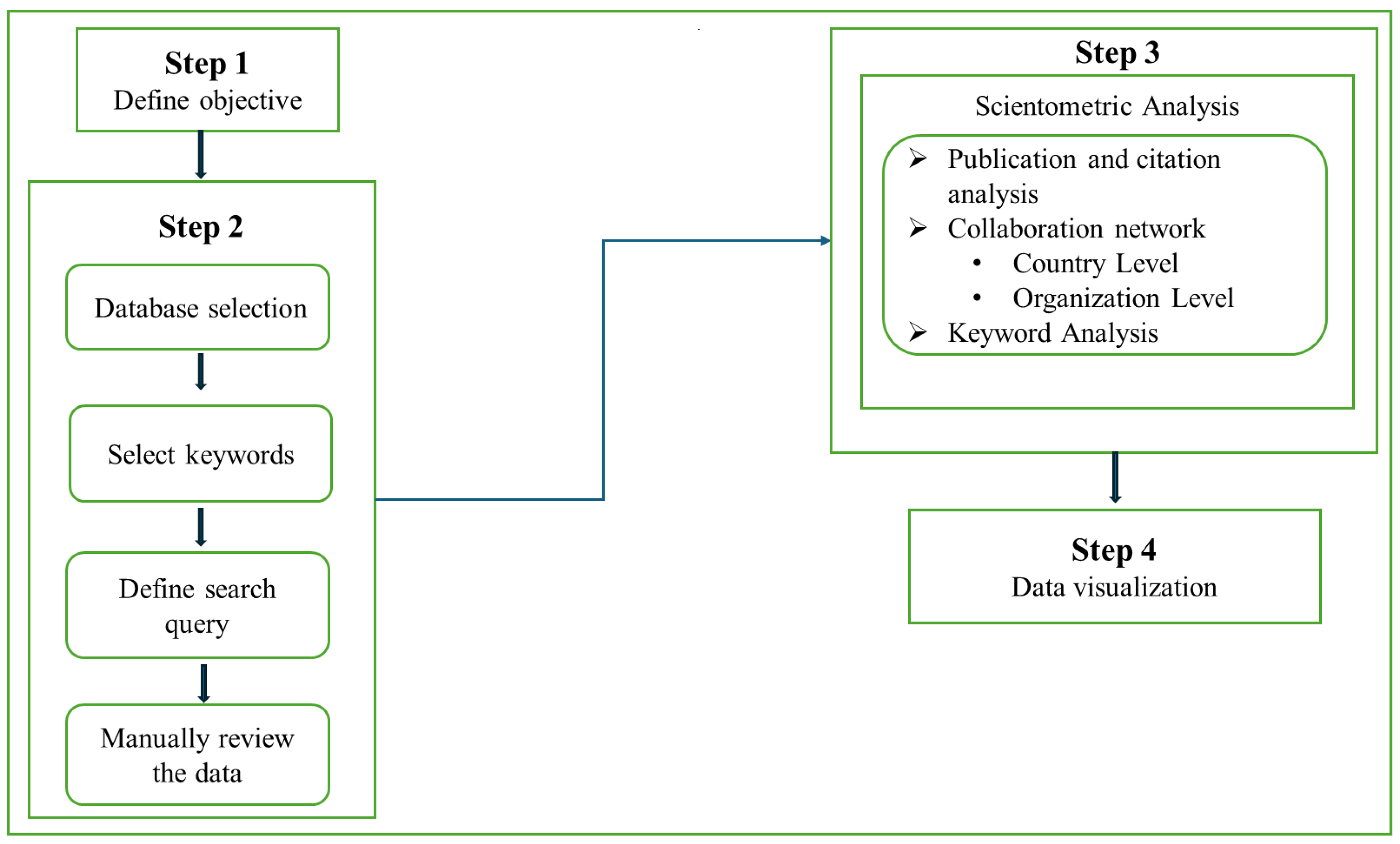
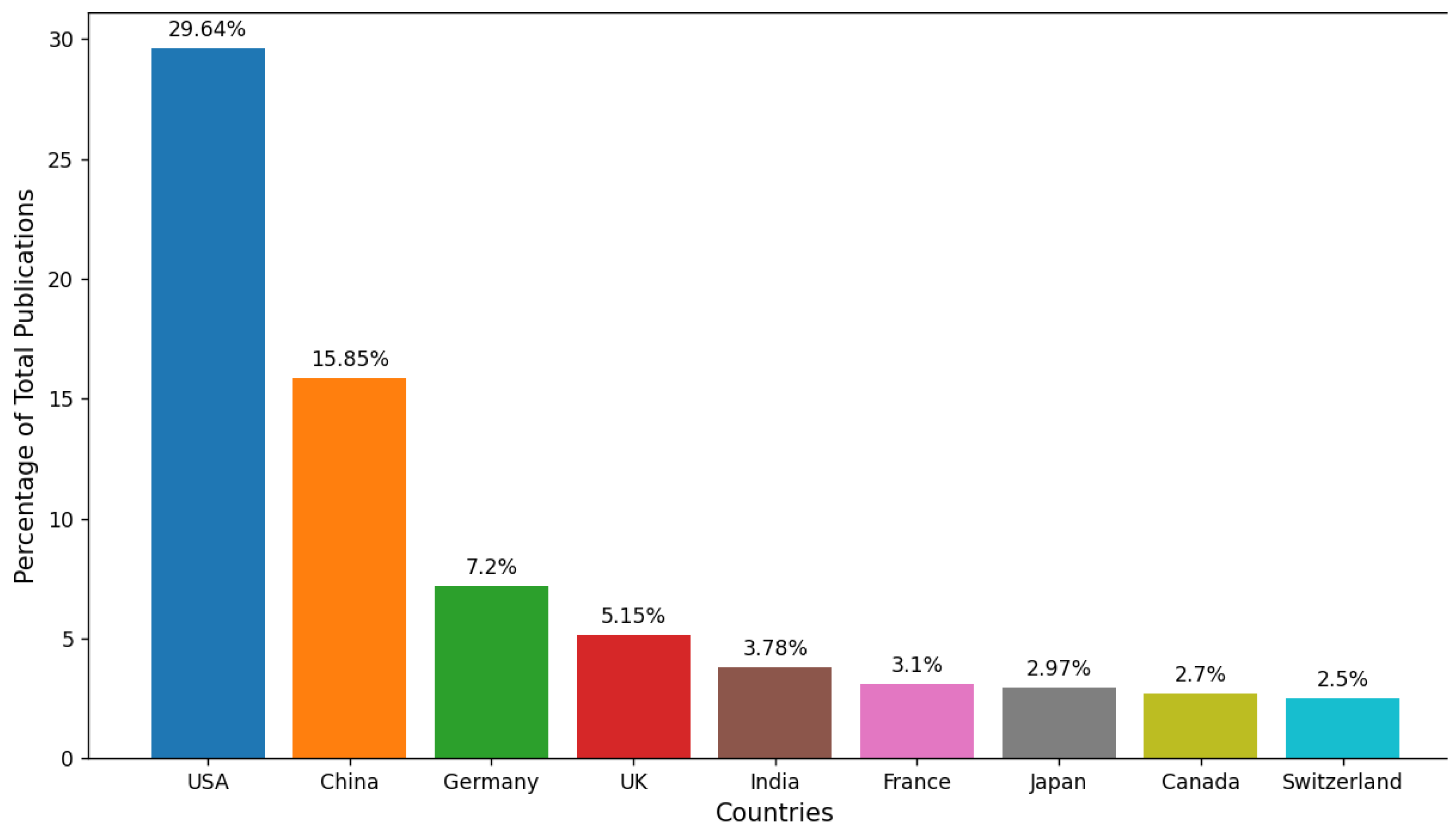
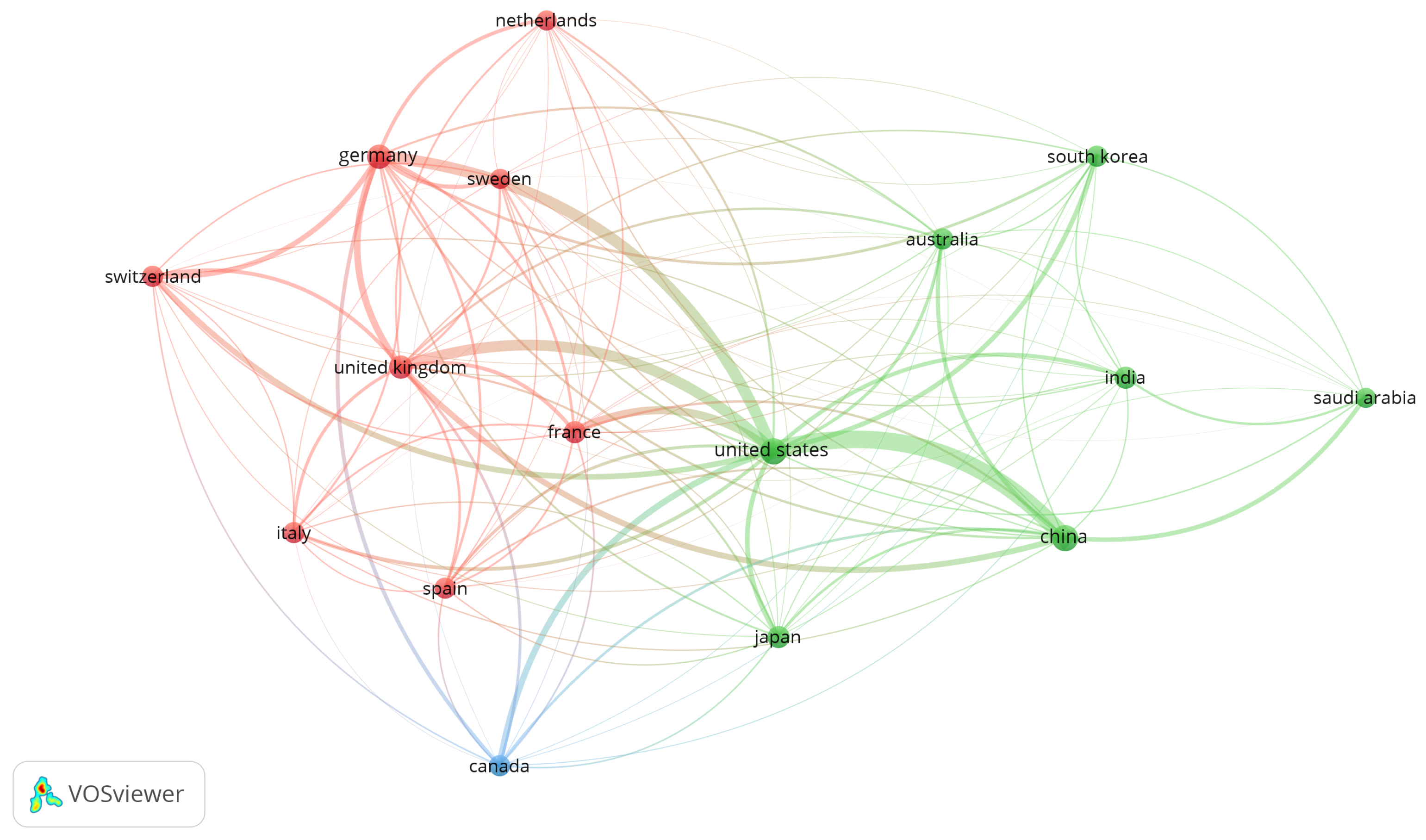

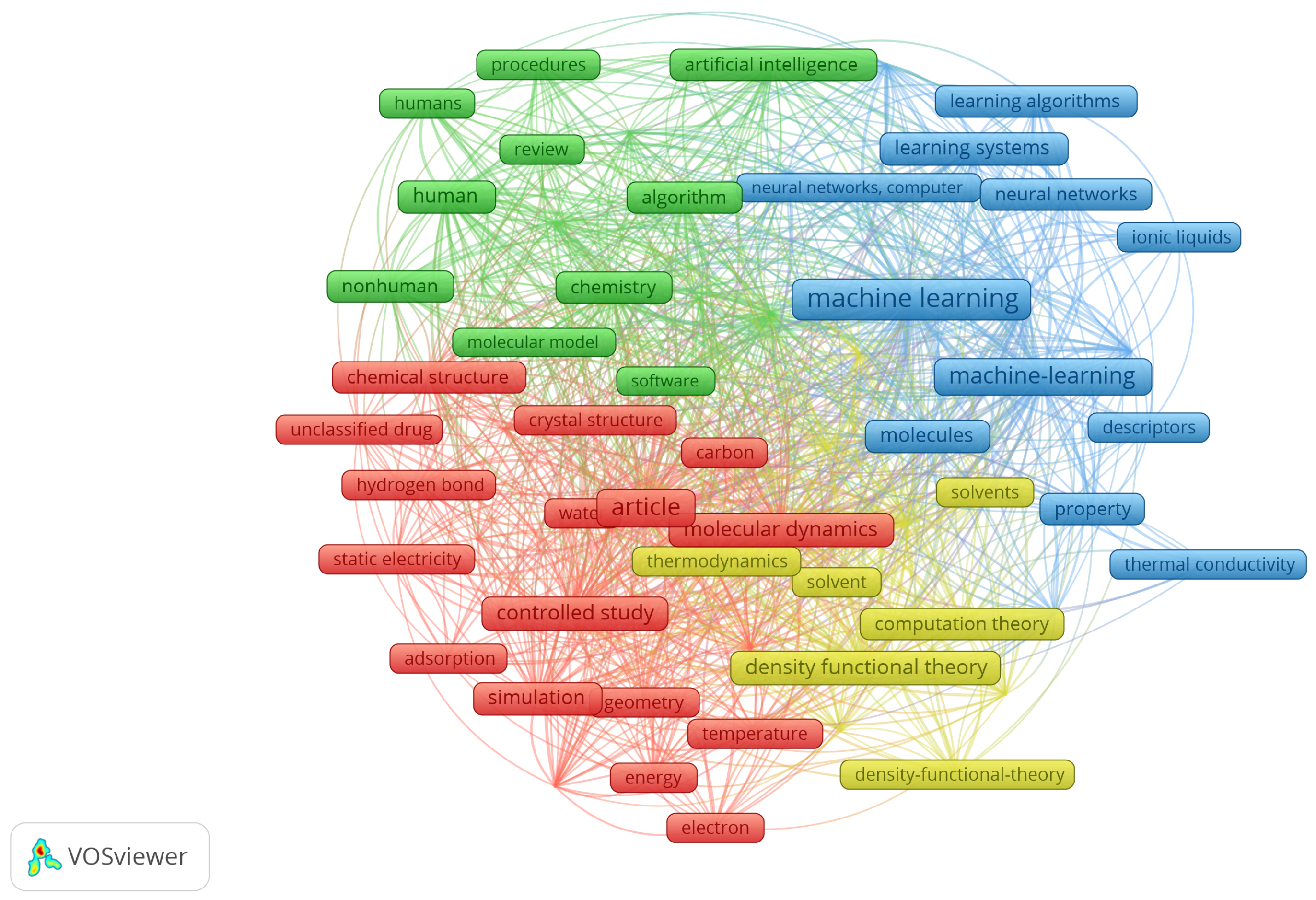
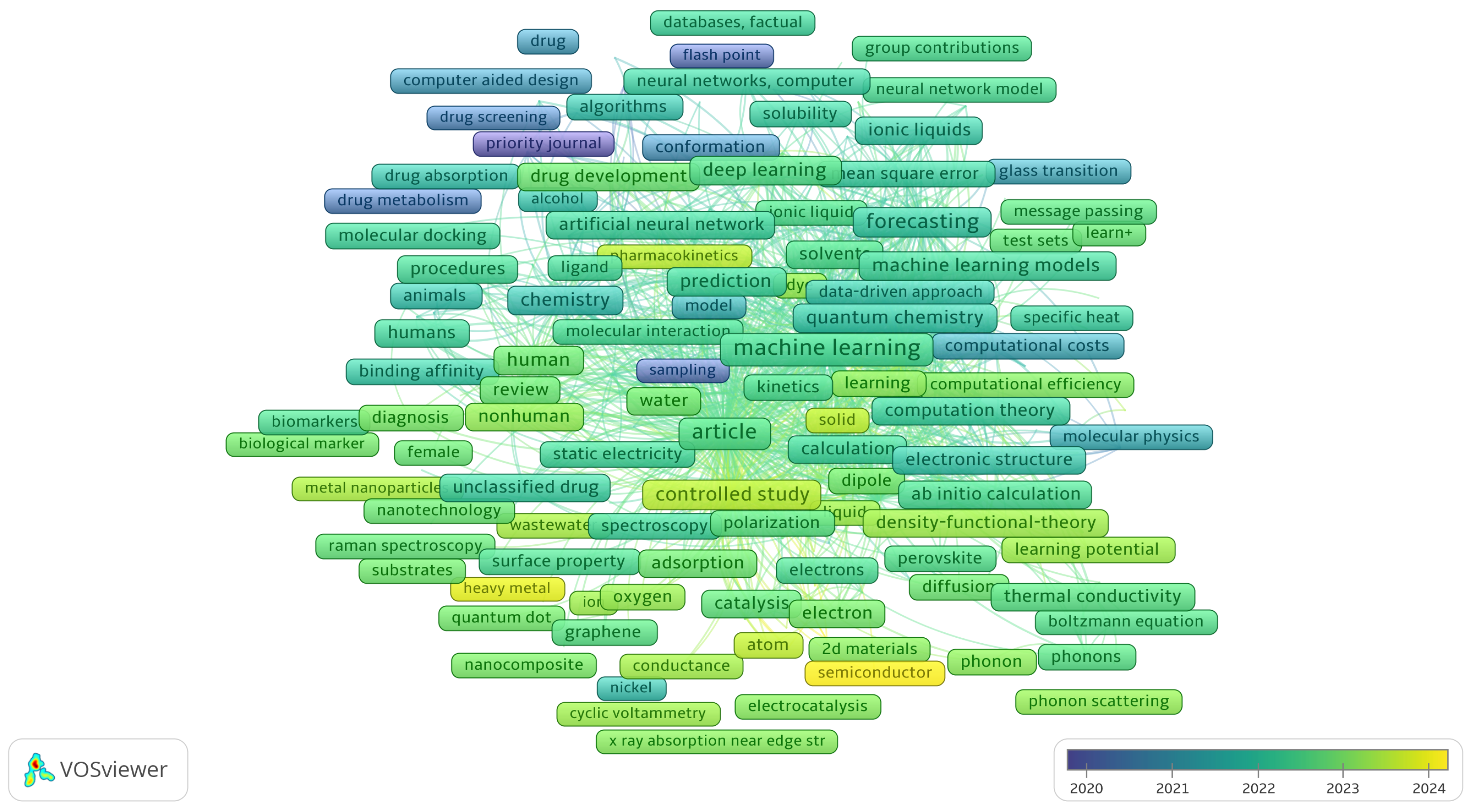
| Publication Period | Total Publications | Citation per Paper | Total Citation |
|---|---|---|---|
| 2014 | 2 | 4100 | 8201 |
| 2015 | 7 | 1477 | 10,339 |
| 2016 | 12 | 494.5 | 5394 |
| 2017 | 21 | 288.143 | 6051 |
| 2018 | 41 | 144.32 | 5917 |
| 2019 | 73 | 79.92 | 5834 |
| 2020 | 134 | 47.44 | 6358 |
| 2021 | 240 | 26.66 | 6400 |
| 2022 | 297 | 13.12 | 3915 |
| 2023 | 446 | 5.405 | 2411 |
| 2024 | 653 | 0.77 | 505 |
| Country | Documents |
|---|---|
| USA | 608 |
| China | 495 |
| Germany | 225 |
| U.K. | 161 |
| India | 118 |
| France | 97 |
| Japan | 93 |
| Canada | 87 |
| Switzerland | 80 |
| Year | Source Title | Cited by | NCII |
|---|---|---|---|
| 2020 | Information Fusion | 4636 | 79.93 |
| 2021 | Journal of Big Data | 3565 | 74.27 |
| 2017 | Journal of Physics Condensed Matter | 2649 | 91.34 |
| 2020 | Journal of Chemical Physics | 1769 | 11.63 |
| 2020 | Mechanical Systems and Signal Processing | 1755 | 12.71 |
| 2018 | Physical Review Letters | 1425 | 11.87 |
| 2020 | Chemical Reviews | 1185 | 9.87 |
| 2017 | Journal of Materiomics | 893 | 68.69 |
| 2021 | Journal of Chemical Physics | 663 | 4.27 |
| 2019 | Optica | 608 | 38.00 |
| S. No | Author | Documents | Citations | TLS |
|---|---|---|---|---|
| 1 | Green, William H. | 14 | 948 | 14 |
| 2 | Kulik, Heather J. | 12 | 464 | 16 |
| 3 | Csanyi, Gabor | 12 | 1088 | 6 |
| 4 | Dornheim, Tobais | 11 | 202 | 17 |
| 5 | Darwish, Ahmad S. | 10 | 236 | 33 |
| 6 | Vorberger, Jan | 10 | 184 | 17 |
| 7 | Margraf, Johannes T. | 10 | 187 | 12 |
| 8 | Reuter, Karsten | 10 | 185 | 12 |
| 9 | Coley, Connor W. | 10 | 1113 | 7 |
| 10 | Lemaoui, Tarek | 9 | 215 | 33 |
| S. No | Keywords | Occurence |
|---|---|---|
| 1 | ab initio calculation | 79 |
| 2 | Adsorption | 57 |
| 3 | Article | 752 |
| 4 | Calculation | 91 |
| 5 | Carbon | 52 |
| 6 | Catalyst | 41 |
| 7 | Catalysis | 64 |
| 8 | Chemical Structure | 95 |
| 9 | Controlled Study | 314 |
| 10 | Crystal Structure | 64 |
| 11 | Electron | 68 |
| 12 | Energy | 89 |
| 13 | Geometry | 69 |
| 14 | Hydrogen | 56 |
| 15 | Hydrogen Bond | 57 |
| 16 | Molecular Dynamics | 286 |
| 17 | Quantum Mechanics | 44 |
| 18 | Simulation | 158 |
| 19 | Statical Electricity | 57 |
| 20 | Temperature | 78 |
| 21 | Unclassified Drug | 55 |
| 22 | Water | 70 |
| S. No | Keyword | Occurence |
|---|---|---|
| 1 | Algorithm | 122 |
| 2 | Artificial Intelligence | 138 |
| 3 | Cheminformatics | 52 |
| 4 | Chemistry | 142 |
| 5 | Computer Model | 49 |
| 6 | Drug Development | 64 |
| 7 | Human | 216 |
| 8 | Humans | 74 |
| 9 | Molecular Model | 49 |
| 10 | Non Human | 105 |
| 11 | Prediction | 201 |
| 12 | Procedure | 66 |
| 13 | Quantitative Structure Activity Relation | 53 |
| 14 | Review | 73 |
| 15 | Software | 48 |
| 16 | Support Vector Machine | 44 |
| S. No | Keyword | Occurence |
|---|---|---|
| 1 | Machine Learning | 1173 |
| 2 | Artificial Neural Network | 94 |
| 3 | Atoms | 87 |
| 4 | Deep Learning | 137 |
| 5 | Descriptions | 78 |
| 6 | Forecasting | 430 |
| 7 | Iconic Liquid | 73 |
| 8 | Learning Algorithm | 118 |
| 9 | Learning Systems | 187 |
| 10 | Machine-Learning | 627 |
| 11 | Machine Learning Models | 178 |
| 12 | Molecules | 179 |
| 13 | Neural Networks | 117 |
| 14 | Neural Networks, Computer | 47 |
| 15 | Property | 109 |
| 16 | Thermal Conductivity | 74 |
| S. No | Keyword | Occurence |
|---|---|---|
| 1 | Computational Theory | 102 |
| 2 | Computational Chemistry | 87 |
| 3 | Density Functional Theory | 85 |
| 4 | Density-Functional-Theory | 308 |
| 5 | Electronic Structure | 93 |
| 6 | Free Energy | 67 |
| 7 | Quantum Chemistry | 11 |
| 8 | Quantum Theory | 146 |
| 9 | Solvent | 57 |
| 10 | Solvents | 55 |
| 11 | Thermodynamics | 91 |
Disclaimer/Publisher’s Note: The statements, opinions and data contained in all publications are solely those of the individual author(s) and contributor(s) and not of MDPI and/or the editor(s). MDPI and/or the editor(s) disclaim responsibility for any injury to people or property resulting from any ideas, methods, instructions or products referred to in the content. |
© 2025 by the authors. Licensee MDPI, Basel, Switzerland. This article is an open access article distributed under the terms and conditions of the Creative Commons Attribution (CC BY) license (https://creativecommons.org/licenses/by/4.0/).
Share and Cite
Tomar, M.; Prajapat, S.; Kumar, D.; Kumar, P.; Kumar, R.; Vasilakos, A.V. Exploring the Role of Material Science in Advancing Quantum Machine Learning: A Scientometric Study. Mathematics 2025, 13, 958. https://doi.org/10.3390/math13060958
Tomar M, Prajapat S, Kumar D, Kumar P, Kumar R, Vasilakos AV. Exploring the Role of Material Science in Advancing Quantum Machine Learning: A Scientometric Study. Mathematics. 2025; 13(6):958. https://doi.org/10.3390/math13060958
Chicago/Turabian StyleTomar, Manish, Sunil Prajapat, Dheeraj Kumar, Pankaj Kumar, Rajesh Kumar, and Athanasios V. Vasilakos. 2025. "Exploring the Role of Material Science in Advancing Quantum Machine Learning: A Scientometric Study" Mathematics 13, no. 6: 958. https://doi.org/10.3390/math13060958
APA StyleTomar, M., Prajapat, S., Kumar, D., Kumar, P., Kumar, R., & Vasilakos, A. V. (2025). Exploring the Role of Material Science in Advancing Quantum Machine Learning: A Scientometric Study. Mathematics, 13(6), 958. https://doi.org/10.3390/math13060958







